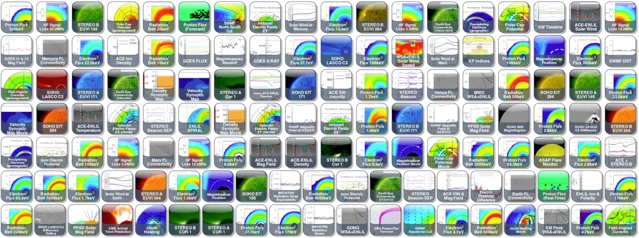iSWA
About
The integrated Space Weather Analysis (iSWA) system is a flexible, turn-key, Web-based dissemination system for NASA-relevant space weather information that combines forecasts based on the most advanced space weather models with concurrent space environment information. iSWA provides access to continuous/real-time model output ran at the CCMC. iSWA is customer-configurable and adaptable for use as a powerful decision-making tool. The system offers an unprecedented ability to analyze the present and expected future space weather impacts on NASA' s human and robotic missions.
Disclaimer
The near real-time simulation outputs and derived real-time data products displayed on iSWA should be considered only as prototyping quality and in research context.
Latest News
- June 2024: Deployed a new version of the ISWA web app at the CCMC. The new version includes the following features:
- Global time sync of all cygnets
- Save layouts (in JSON files)
- Snap-2-Grid
- Search capability
Publication Policy
For tracking purposes for our government sponsors, we ask that you notify the CCMC whenever you use any CCMC tools/software systems in any scientific publications and/or presentations. Follow the steps on the publication submission page
See our full publication policy for a sample 'acknowledgement statement' to be included in your publication.
iSWA Cygnets
The iSWA cygnet catalog includes a wide array of space weather analysis products. Simply select the cygnets of interest to create your own custom layout. Click the 'Save Layout' option to save your layout in a JSON file. To get back to the same layout, click the 'Load Layout' option and select the previously saved JSON file to reload it. You can share your layouts with others by sending them the corresponding JSON files.

iSWA Data Tree
All files ingested into iSWA are also publicly accessible via the iswa-data-tree URL.
iSWA Web Services
Numerical Time Series (HAPI)
All 1-D numerical time-series data ingested into iSWA are accessible via iSWA HAPI. Visit https://iswa.ccmc.gsfc.nasa.gov/IswaSystemWebApp/hapi/ for full details. DataStreamServlet has been replaced by ISWA HAPI.
Examples:
https://iswa.ccmc.gsfc.nasa.gov/IswaSystemWebApp/hapi/catalog
https://iswa.ccmc.gsfc.nasa.gov/IswaSystemWebApp/hapi/info?id=goesp_mag_p1m
Datafeed Information
Provides description and date range for specific data feed.
https://iswa.ccmc.gsfc.nasa.gov/IswaSystemWebApp/
DataInfoServlet?id=DATAIDdataID = unique data identifier used to select a specific iSWA data feed.
Example:
https://iswa.ccmc.gsfc.nasa.gov/IswaSystemWebApp/DataInfoServlet?id=309
Data Files between Dates
https://iswa.gsfc.nasa.gov/IswaSystemWebApp/FilesInRangeServlet?
dataID=DATAID&
time.min=YYYY-MM-DDTHH:mm:SS&
time.max=YYYY-MM-DDTHH:mm:SSdataID = unique data identifier used to select a specific iSWA data feed.
time.min = UTC timestamp format: YYYY-MM-DDTHH:mm:SS
time.max = UTC timestamp format: YYYY-MM-DDTHH:mm:SS
Example:
Recent Data Files
https://iswa.gsfc.nasa.gov/IswaSystemWebApp/RecentFilesServlet?
dataID=DATAID&
n=FILECOUNTdataID = unique data identifier used to select a specific iSWA data feed.
n = number of files
Example:
https://iswa.ccmc.gsfc.nasa.gov/IswaSystemWebApp/RecentFilesServlet?dataID=309&n=5
Nearest Data File
https://iswa.gsfc.nasa.gov/IswaSystemWebApp/NearestFilesServlet?
dataID=DATAID&
timestamp=YYYY-MM-DD HH:mm:ssdataID = unique data identifier used to select a specific iSWA data feed.
timestamp = UTC timestamp in YYYY-MM-DD HH:mm:ss format
Example:
Stream Images
This service is deprecated and soon to be replaced.
https://iswa.gsfc.nasa.gov/IswaSystemWebApp/iSWACygnetStreamer?
cygnetid=CYGNETID&
timestamp=YYYY-MM-DD HH:mm:SS&
window=-1
cygnetID = unique data identifier used to select a specific iSWA Cygnet
timestamp = UTC timestamp in YYYY-MM-DD HH:mm:ss format
window = -1 or 0 (-1 matches the most recent data whose timestamp is less than specified AND 0 only returns data that matches the timestamp exactly)
width (optional) = image width size
height (optional) = image height size
Example:
Stream Text
This service is deprecated and soon to be replaced.
https://iswa.gsfc.nasa.gov/IswaSystemWebApp/iSWADataStreamer?
dataid=DATAID&
timestamp=YYYY-MM-DD HH:mm:SS&
window=-1dataID = unique data identifier used to select a specific iSWA datafeed
timestamp = UTC timestamp in YYYY-MM-DD HH:mm:ss format
window = -1 or 0 (-1 matches the most recent data whose timestamp is less than specified AND 0 only returns data that matches the timestamp exactly)
duration (optional) = the number of days data, must be <= 10 days
end-time (optional) = UTC timestamp in YYYY-MM-DD HH:mm:ss format
begin-time (optional) = UTC timestamp in YYYY-MM-DD HH:mm:ss format
Example: